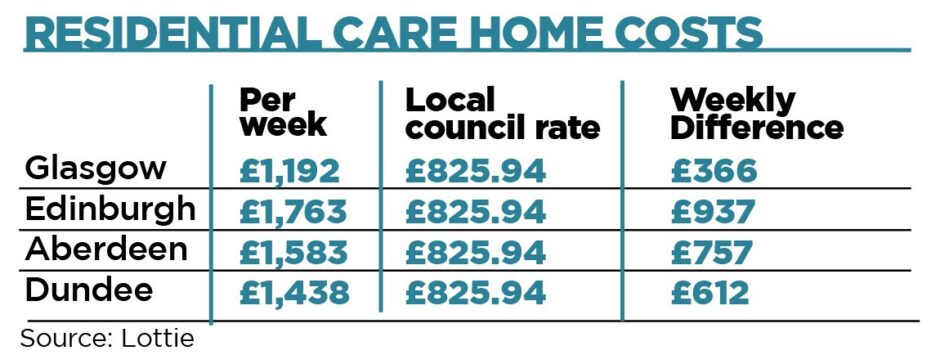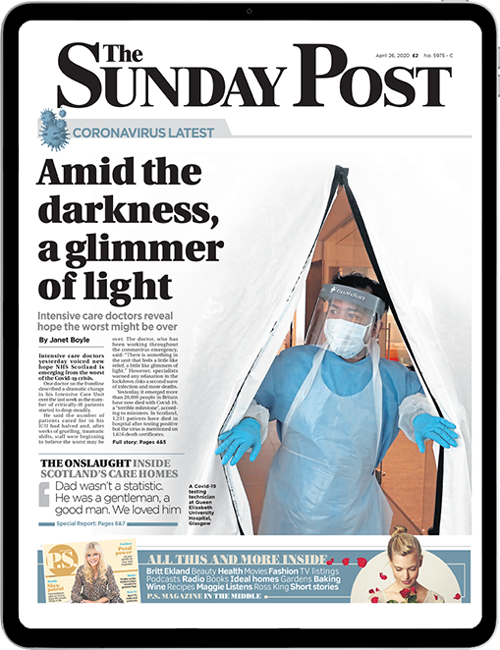
Self-funding care home residents are facing sky-high price rises, leading to fears some are effectively subsidising those paid for by the local authority.
Now care providers and charities are calling for a major overhaul of funding for social care.
Providers in Scotland are experiencing a tidal wave of rising costs, including energy bills, the increase to the National Living Wage and the rise in employers’ National Insurance.
As a result, self-funded residents have seen as much as a 9.5% increase in fees.
Nursing care in Scotland costs £1,549 per week, but the local council standard rate is £948.59, creating a shortfall of more than £600.
In some areas, self-funders are paying twice the rate forked out by the local council.

Now Lottie, an online service which helps retirees find the best UK care homes, home care and retirement living options, has warned this disparity means some residents subsidise others.
The firm’s customer care lead Hannah Karim said: “As care costs rise and local councils’ contributions are capped or limited by government funding, those who do not qualify for funding support, or are paying for their own care, face higher fees to bridge the gap. With a third of UK care providers operating in deficit, this is an unsustainable way to structure the cost of care. However, tackling this issue must begin with government and policymakers committing to increased and sustained funding for social care.”
Currently 65% of people looking for elderly care are struggling to afford increasing costs and access to the services they need.
Karim added: “Many are forced to make difficult decisions, often looking to sell their homes or dipping into personal savings just to afford essential support. More recently, we have found a growing number of families having to move loved ones to different care homes due to rising fees.”
But Age Scotland challenged the claim that self-funders were subsidising other residents.
It said: “The vast majority of residents contribute towards their care beyond the local authority rates, often through their state pension and other income. Very few, if any, pay nothing at all. There’s a common perception that self-funders are ‘subsidising’ those on local authority rates, but the reality is more complex.
“What we’re seeing is that many care homes prioritise residents who can self-fund, often requiring people to have two to three years’ worth of the highest rate of fees available before they are offering a place.
“We’re worried that people who need residential care are locked out when places become available as they just can’t afford it or need to uproot their lives and move considerable distances to somewhere able to take them.”
Sarah was told the care home fees for her parents would increase by £21,173.60 a year. She said: “I was shocked.
“With the new increase of 13.85%, the total cost came to £174,773.60 per year, which is £21,173.60 more. I had to sell my parents’ home to fund their care, and promised them I would make every penny count, so we decided to look into new options.”
Scottish Care, who represent the largest group of independent sector providers across Scotland, said there is a significant and growing shortfall between what local councils pay for placements and the true cost of care paid by private clients.
It said: “In areas where it is challenging to attract enough private clients, care homes face stark choices – either accept lower-paying council-funded residents and absorb the loss, or close their doors altogether. This highlights the urgent need for a sustainable, long-term funding solution for social care.”
Last week Robert Kilgour, executive chairman of Renaissance Care, warned of mass closures within months due to the financial crisis.
The Scottish Government said: “We recognise the cost of residential care can be high for many people. This is why we have increased the rates for Free Personal and Nursing Care by 16.8% since April 2022, through an additional investment of £41.5 million.
“We are not responsible for determining the fees set by private care home providers for people who are self-funding their care.”

Enjoy the convenience of having The Sunday Post delivered as a digital ePaper straight to your smartphone, tablet or computer.
Subscribe for only £5.49 a month and enjoy all the benefits of the printed paper as a digital replica.
Subscribe © Supplied
© Supplied